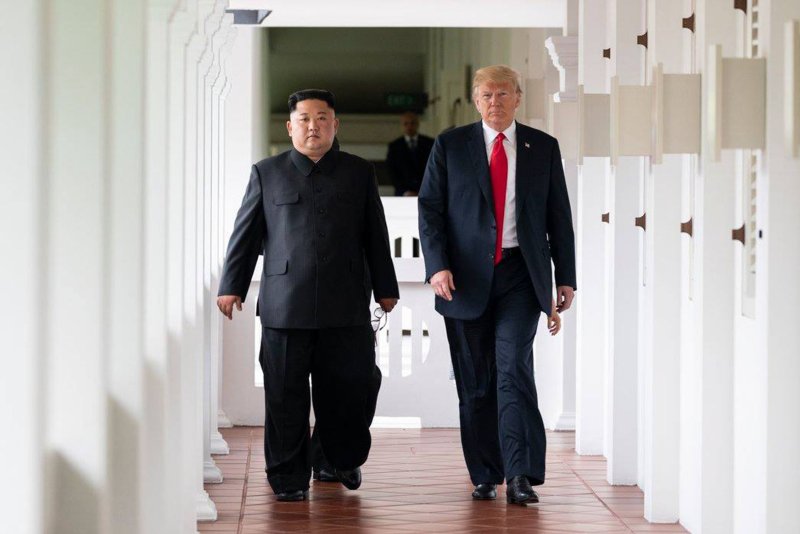June 12 (UPI) -- It seems ages since a lingering handshake began across the demarcation line that separates North and South Korea. Much has happened since -- and now, the once unthinkable has happened with a summit between North Korea's Kim Jong Un and the United States' Donald Trump. But in all the frenzied coverage of that summit -- which yielded an agreement widely considered anemic -- it's easy to forget that the unprecedented peace process between the Koreas was already underway.
A number of pledges were made at the April Inter-Korean Summit between Moon Jae-in, president of South Korea, and Kim. Among their promises were an agreement to work toward the denuclearization of the Korean Peninsula and to convert the Korean Armistice Agreement into a full peace treaty that would formally end the Korean War after 65 years.
A Korean peace treaty would most likely do three things: formally designate the two Korea's borders (probably as they currently stand), put in place certain processes that would resolve any future disputes and potentially open the North for economic investment and cease current sanctions. But what about unification? Would a peace treaty end any prospects of unification, with each country recognizing the other's existence, or might it install a system of governance that the two countries could share -- a federal system, for example?
Related
The key question is what Kim really wants. If all he really desires is a ceremonial role -- devoid of power, but with all the pomp and circumstance befitting a "supreme leader" -- a unified Korea might look something like a constitutional monarchy. Kim could be granted discretionary powers, as is Morocco's Mohammed VI, or hold no formal authority at all, as does Japan's Emperor Akihito. As in the U.K. and the Commonwealth, he could be "a sovereign who reigns but does not rule."
For many reasons, this is highly unlikely.
Striking a balance
Kim has given no indication that he is interested in relinquishing any power over his part of the peninsula; nor has Moon. As such, the most likely outcome is still a peninsula of two Koreas, however cordial their relationship.
After all, it has been more than 65 years since Korea was unified in any form. And even then, it was never really formalized after the Japanese surrender at the end of World War II. Today's younger Koreans have no memory of the "unifed" state, and more and more young people in South Korea seem content with the idea of two Koreas. After all, it's perfectly normal for two countries to share historical heritage and linguistic background without thinking of themselves as a single "divided nation."
This fits a global trend toward a world of more smaller countries, not new larger ones. The only countries growing in size are taking their new territory by force or subterfuge, as did Russia in its annexation of the Crimea.
If a stable two-country system was to endure, the parties on all sides would need to accept some inconvenient truths. For a start, North Korea is a nuclear state, and in a sense always will be; "full" denuclearization is not possible, because it already knows how to manufacture a nuclear weapon. The United States will also not leave the Korean Peninsula entirely because it has another reason to stay there: to keep a strategic foothold in East Asia so as to mitigate the influence of China.
Holding on
So what does Kim want in the short term, and what does he need? In short, a way forward for North Korea that doesn't put his domestic supremacy at risk. Conventional wisdom has long held that as a country modernizes its economy, democracy is sure to follow, as happened in both South Korea and Taiwan in the 1980s. But despite initial predictions, the same effect has not taken hold in China.
Instead, the Chinese Communist Party's authoritarian rule is being consolidated. China's current president, Xi Jinping, only this year announced that the term limit on his office would be scrapped, potentially allowing him to rule for life. Xi's example will surely have given Kim hope that he can modernize North Korea's dismal economy without relaxing or losing his hold on power.
As the world order becomes more and more dominated by the relationship between two superpowers, North Korea may once again look to play China off against its principal rival, as it did in the 1960s after the Sino-Soviet split. In so doing, Kim can reap the maximum benefit in terms of economic, political, and potentially military aid -- all of which will in turn help him retain power even as North Korea grows and living conditions there improve.
![]() Aligning with the United States would be a bold move, but Trump's pride in "making a deal," however thin, is very much to Kim's benefit. It gives him the room for maneuvering he badly needs to move forward without putting his regime at risk. Still, nothing should be taken for granted: As the last few months have proven, everything could suddenly change.
Aligning with the United States would be a bold move, but Trump's pride in "making a deal," however thin, is very much to Kim's benefit. It gives him the room for maneuvering he badly needs to move forward without putting his regime at risk. Still, nothing should be taken for granted: As the last few months have proven, everything could suddenly change.
Niki J.P. Alsford is a reader in Asia Pacific Studies and director of the International Institute of Korean Studies at the University of Central Lancashire.
This article was originally published on The Conversation. Read the original article.















